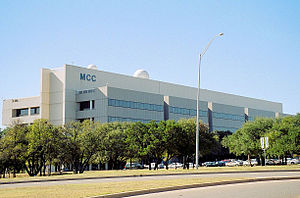- Microelectronics and Computer Technology Corporation
-
Coordinates: 30°23′43.22″N 97°44′6.76″W / 30.3953389°N 97.7352111°W
 The MCC headquarters building in Austin, Texas
The MCC headquarters building in Austin, Texas
Microelectronics and Computer Technology Corporation (Microelectronics and Computer Consortium - MCC) was the first, and - at one time - one of the largest, computer industry research and development consortia in the United States.
MCC did research and development in the following areas: [1]
- System Architecture and Design (optimise hardware and software design, provide for scalability and interoperability, allow rapid prototyping for improved time-to-market, and support the re-engineering of existing systems for open systems).
- Advanced Microelectronics Packaging and Interconnection (smaller, faster, more powerful, and cost-competitive).
- Hardware Systems Engineering (tools and methodologies for cost-efficient, up-front design of advanced electronic systems, including modelling and design-for-test techniques to improve cost, yield, quality, and time-to-market).
- Environmentally Conscious Technologies (process control and optimisation tools, information management and analysis capabilities, and non-hazardous material alternatives supporting cost-efficient production, waste minimisation, and reduced environmental impact).
- Distributed Information Technology (managing and maintaining physically distributed corporate information resources on different platforms, building blocks for the national information infrastructure, networking tools and services for integration within and between companies, and electronic commerce).
- Intelligent Systems (systems that "intelligently" support business processes and enhance performance, including decision support, data management, forecasting and prediction).
Contents
History
In late 1982, several major computer and semiconductor manufacturers in the United States banded together and founded MCC under the leadership of Admiral Bobby Ray Inman, whose previous positions had been Director of the National Security Agency and Deputy Director of the Central Intelligence Agency as an American answer to Japan's Fifth Generation Project, a large Japanese research project aimed at producing a new kind of computer by 1991. The Japanese had formed consortia as early as 1956. [2] Such formations were illegal in the United States until the 1984 Congressional passage of the "National Cooperative Research Act" [3] Many European and American computer companies saw this new Japanese initiative as an attempt to take full control of the world's high-end computer market, and MCC was created, in part, as a defensive move against that threat. Several sites were considered; Austin, Texas was selected.
Despite this purpose and the background of Inman and his senior staff, MCC accepted no government funding for many years and was a refuge for some avoiding work on Strategic Defense Initiative projects. MCC was part of the Artificial Intelligence boom of the 1980s, reportedly the single largest customer of both Symbolics and Lisp Machines, Inc. (and like Symbolics, was one of the first companies to register a .com domain). In the 1980s its major programs were Packaging, Software Engineering, CAD, and Advanced Computer Architectures. The latter comprised Artificial Intelligence, Human Interface, Database, and Parallel Processing, the latter two merging in the late 1980s.
Many of the early shareholder companies were mainframe computer companies under stress in the 1980s. Over the years, MCC's membership diversified to include a broad range of high-profile corporations involved in information technology products, as well as government research and development agencies and leading universities.
In June, 2000 the MCC Board of Directors voted to dissolve the consortium, and the few remaining employees held a wake at Scholz's Beer Garden in Austin on October 25. Formal dissolution papers were reportedly not filed until 2004.
See also
Notes
- ^ , Microelectronics and Computer Technology Corporation, entry from The Free Online Dictionary of Computing.
- ^ , David V. Gibson and Everett M. Rogers, R&D Collaborations On Trial, Harvard Business School Press, 1994, ISBN 0-87584-364-6, Introduction, p. 15.
- ^ , Ibid., Chapter 7.
External links
- Oral history interview with Laszlo A. Belady, Charles Babbage Institute, University of Minnesota. Discusses his tenure as Vice President and Program Director of the Microelectronics and Computer Technology Corporation (MCC); as Chairman, CTO, and CEO of the Mitsubishi Electric Research Laboratories, Inc. (MERL); and as Executive Director of the Austin Software Council.
- Microelectronics and Computer Technology Corporation. FOLDOC. Retrieved Nov. 17, 2005.
- Microelectronics and Computer Technology Corporation, from The Free Online Dictionary of Computing.
City of Austin History · Metro Area Counties Important
businessesHigher
educationMusic Antone's · Armadillo World Headquarters · Austin City Limits · Austin Lyric Opera · Austin Symphony Orchestra · Emo's · SXSW · Stevie Ray Vaughan · Willie NelsonLandmarks Austin-Bergstrom International Airport · Darrell K Royal-Texas Memorial Stadium · Dell Diamond · The Drag · Frank Erwin Center · Governor's Mansion · Lyndon Baines Johnson Library and Museum · Moonlight tower · Sixth Street · South Congress · State Capitol · Treaty Oak · UFCU Disch-Falk Field · University of Texas TowerParks and
preservesAuditorium Shores · Emma Long · Hippie Hollow · McKinney Falls · Mount Bonnell · Walnut Creek · Wild Basin · ZilkerBodies of
waterCategories:- History of artificial intelligence
- Companies established in 1992
- Companies based in Austin, Texas
- Companies disestablished in 2000
- Computer science stubs
Wikimedia Foundation. 2010.
